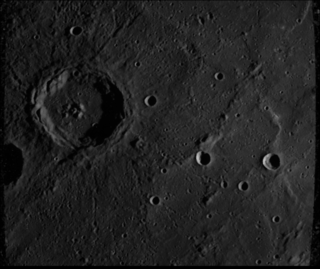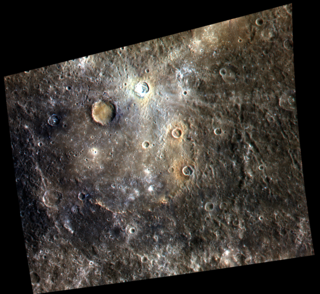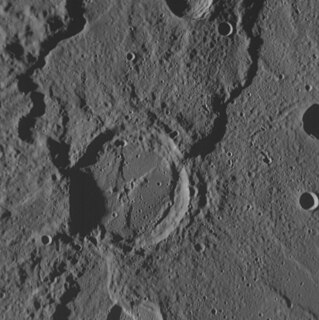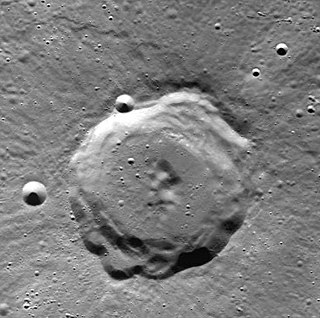
Canso is a Martian crater. It lies about 450 kilometres west of the Viking 1 lander, slightly northeast of Lunae Planum, and west of Chryse Planitia, in the Lunae Palus quadrangle. The crater is named after Canso, a fishing town in Nova Scotia. The name was officially adopted in 1988 by the International Astronomical Union's Working Group for Planetary System Nomenclature (IAU/WGPSN).

Apollo is an enormous impact crater located in the southern hemisphere on the far side of the Moon. This formation dwarfs the large crater Oppenheimer that is located next to the western rim. The crater Barringer lies across the northern wall. To the southeast is the crater Anders, and Kleymenov is just to the east of the rim.

Zola is a crater on Mercury. The crater was named after the French novelist and playwright Émile Zola by the IAU in 1979.

Homer is a crater on Mercury. It is one of many Peak-ring basins on Mercury.

Munkácsy is a crater on Mercury. Munkácsy originally had a double-ring basin structure, but most of the inner ring was buried when the basin was flooded with volcanic lava. Only a few remnants of the ring poke up through the lava, although low ridges in the lava seem to trace out much of the rest of the ring's circumference.

Neumann is a crater on Mercury. It has a diameter of 120 kilometers. Its name was adopted by the International Astronomical Union (IAU) in 1976. Neumann is named for the German architect Johann Balthasar Neumann, who lived from 1687 to 1753.

McLaughlin Crater is an old crater in the Oxia Palus quadrangle of Mars, located at 21.9°N 337.63°E. It is 90.92 km (56.50 mi) in diameter and 2.2 km (1.4 mi) deep. The crater was named after Dean B. McLaughlin, an American astronomer (1901-1965). The Mars Reconnaissance Orbiter has found evidence that the water came from beneath the surface between 3.7 billion and 4 billion years ago and remained long enough to make carbonate-related clay minerals found in layers. McLaughlin Crater, one of the deepest craters on Mars, contains Mg-Fe clays and carbonates that probably formed in a groundwater-fed alkaline lake. This type of lake could have had a massive biosphere of microscopic organisms.

Darwin is an impact crater on Mars, located at 57°S 19°E to the southeast of Argyre Planitia in Noachis Terra. It is approximately 176 km in diameter. The crater's name was formally approved by the IAU in 1973.

Roddenberry is a crater on Mars, located at 49°S 4°W to the east of Argyre Planitia in Noachis Terra. It measures approximately 139 kilometers in diameter. The crater is named after Gene Roddenberry, creator of the television series Star Trek, and was formally approved by the IAU in 1994.

Arrhenius is an impact crater in the Eridania quadrangle on Mars at 40.3° S and 237.4° W. and is 129.0 km (80.2 mi) in diameter. Its name, for Svante Arrhenius, was approved in 1973 by the IAU. Evidence of previous glacial activity is evident in images. There also appear to be branched channels just outside the crater.

Enheduanna is a crater on Mercury. It has a diameter of 105 kilometers. Its name was suggested by Gagan Toor from India in a naming contest which was eventually adopted by the International Astronomical Union (IAU) on 2015. Enheduanna is named for the Sumerian poet Enheduanna. The craters Carolan, Kulthum, Karsh, and Rivera were also named as part of the contest.

Karsh is a crater on Mercury. It has a diameter of 58 kilometers. Its name was suggested by American resident Elizabeth Freeman Rosenzweig in a naming contest which was eventually adopted by the International Astronomical Union (IAU) on 2015. Karsh is named for the Armenian-Canadian photographer Yousuf Karsh. The craters Carolan, Enheduanna, Kulthum, and Rivera were also named as part of the contest.

Kulthum is a crater on Mercury. It has a diameter of 31 kilometers. Its name was suggested by Molouk Ba-Isa from Saudi Arabia, Swiss individual Riana Rakotoarimanana, and American residents Yehya Hassouna, David Suttles, Thorayya Said Giovannelli and Matt Giovannelli in a naming contest which was eventually adopted by the International Astronomical Union (IAU) on 2015. Kulthum is named for the Egyptian singer Umm Kulthum.

Rivera is a crater on Mercury. It has a diameter of 40 kilometers. Its name was suggested by Mexican residents Ricardo Martinez and Arturo Gutierrez, and American residents Rebecca Hare and José Martinez, in a naming contest which was eventually adopted by the International Astronomical Union (IAU) on 2015. Rivera is named for the Mexican poet Diego Rivera. The craters Carolan, Enheduanna, Karsh, and Kulthum were also named as part of the contest.















